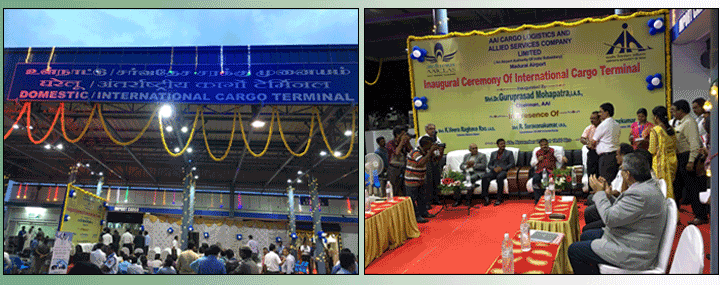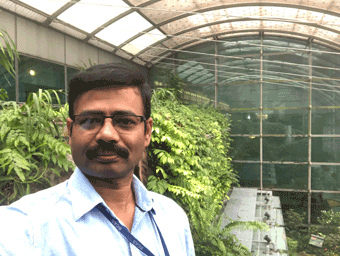| 
 “We
have met the enemy and it is us,” is the air cargo industry response
to India government talk, but there is little action! “We
have met the enemy and it is us,” is the air cargo industry response
to India government talk, but there is little action!
Sure, on paper and in the media, the Indian
government—or rather, the civil aviation ministry—is all for
pushing ahead to boost air cargo, but elsewhere powerful pressures, including
simple indifference to promises and pledges, are working to put brakes
on advancing air cargo in India.
Madurai Airport
Case In Point
A recent case has highlighted the usual
problem of governmental red tape.
Madurai Airport in the south, an international
airport, is connected to Dubai, Abu Dhabi, Doha, Sharjah, Singapore, and
Colombo.
The ‘Temple City’ airport is
known for the export of jasmine flowers (the Madurai Malli) and perishables
like vegetables.
In fact, the first consignment of 300 kg
of Madurai Malli was taken by a SpiceJet flight to Dubai on December 15,
2017 (the international cargo terminal was inaugurated on November 28,
2017).

Forwarder Sues For Service
 Freight
forwarder S. A. Sayeed (Director - Operations, ABS Xpress Private Ltd)
filed A Public Interest Litigation (PIL) in the Madras (Chennai) High
Court, which mentions that the absence of an officer responsible for issuing
the mandatory plant protection certificate had affected the exports of
flowers and other perishables. Freight
forwarder S. A. Sayeed (Director - Operations, ABS Xpress Private Ltd)
filed A Public Interest Litigation (PIL) in the Madras (Chennai) High
Court, which mentions that the absence of an officer responsible for issuing
the mandatory plant protection certificate had affected the exports of
flowers and other perishables.
“Ninety percent of the cargo handled
are perishable agricultural products consisting mainly of vegetables,
flowers such as roses, and Madurai Malli,” the PIL said, adding
that more than 100 metric tons of cargo was being handled at Madurai since
the international air cargo terminal started functioning.
Headless
Quarantine Office
The airport has a Plant Quarantine Office
but there is no officer to head it. Flowers require phytosanitary certificates
and the Agriculture Ministry-controlled plant quarantine office has to
issue an official document.
As a result, freight forwarders/exporters
have to undertake a 900-km journey to the Chennai regional office for
a certificate that is valid for only 24 hours.
The petition said that while this had put
a brake on flower exports from Madurai, it would cause losses to the airport,
the government, and the exporters.
Reports state that the Madurai airport director
had brought this to the attention of the concerned authorities consistently
over the last five months, but nothing happened.
Big Talk
No Listen
 Repeated
assurances from the civil aviation ministry that it is keen to see India’s
current 35th ranking in the World Bank’s Logistics Performance Index
go up higher are underscored by assurances from Vandana Aggarwal, Economic
Advisor to the Ministry of Civil Aviation, declaring that the government
and the ministry are “open to suggestions from the air cargo industry. Repeated
assurances from the civil aviation ministry that it is keen to see India’s
current 35th ranking in the World Bank’s Logistics Performance Index
go up higher are underscored by assurances from Vandana Aggarwal, Economic
Advisor to the Ministry of Civil Aviation, declaring that the government
and the ministry are “open to suggestions from the air cargo industry.
“I can learn from you where you think
things need to change,” are words that seem to fall flat in the
cold light of reality.
Show Us The
Pain
Among the stated top priorities of the civil
aviation ministry are the improvement of regional connectivity, e-transportation,
e-compliance, and the setting up of a grievances body. We are told the
main aim of these initiatives is to reduce the cost of logistics from
13-14 percent of the national GDP to roughly 9 percent by 2022.
“You tell us where the pain point
is and we’ll do our best to remove it,” Aggarwal had said.
“The government is your silent partner.
“This is reality, not just empty words,”
she declared.
Aggarwal was also quoted saying that the
government had an ambitious dream: take India to the 15th position in
the Logistics Performance Index by 2020.
Time May
Be Running Out
Now that the Narendra Modi-led government
has barely a year more of its tenure before India goes for a national
poll, it has to push through all the initiatives that have been launched.
But amidst all the talk and lack of action,
time may be running out this go ‘round.
UDAN Scheme
During the last four years of the government,
The Civil Aviation Ministry has moved ahead to boost infrastructure not
only to facilitate the government’s Regional Connectivity Scheme,
better known as Ude Desh Ka Aam Nagrik (Let the common man fly, or UDAN)
but also to accommodate the growing traffic: both passenger and cargo.
It is a mammoth task for the state-controlled
Airports Authority of India (AAI).
CAPA Weighs
In
In fact, the CAPA India Aviation Outlook
2017/18 pointed out that there was surging traffic, but infrastructure
constraints had become critical and mentioned that the Ministry of Civil
Aviation deserved significant recognition for actively consulting and
engaging with the industry, which was starting to yield results.
It went on to emphasize:
“The strategy of engagement and taking
accountability is highly welcome and demonstrates a commitment to listening
to problems and developing solutions.”
Time To Seize
The Moment
India needs to seize the opportunity because
the potential exists.
Witness the growth.
According to statistics from AAI, total
freight traffic registered a CAGR of 7.08 percent over FY06-17.
During FY06-17, domestic freight traffic
increased at a CAGR of 7.95 percent, while international freight traffic
grew at a CAGR of 6.58 percent during the same period.
In FY17, domestic freight traffic stood
at 1,123.18 million tons, while international freight traffic was at 1,855.06
million tons.
The projection is that by 2023, total freight
traffic will reach 4.14 million tons exhibiting growth at a CAGR of 7.27
percent between FY2016 and FY23.
In addition, international freight traffic
will grow at a CAGR of 7.13 percent while domestic freight traffic will
be expected to grow at a CAGR 7.50 percent between FY2016 and FY23.
Tirthankar Ghosh
|






 Vol.
17 No. 34
Vol.
17 No. 34 Vol.
17 No. 35
Vol.
17 No. 35